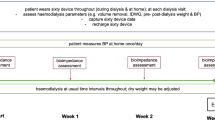Abstract
An instrument for continuous monitoring of fluid-volume changes has been developed. A tetrapolar whole-body impedance technique is employed with a constant current of 100 μA at 1·5 kHz and 150 kHz. A microprocessor automatically calculates changes in fluid volume from changes in whole-body impedance. Body-surface area is used as a normalising factor together with an empirically determined constant to obtain readings expressed in litres. Estimates of fluid-volume changes obtained by the method were compared with concomitant changes in the body weight of ten patients undergoing haemodialysis, and a correlation coefficient of 0·89 was found.
Similar content being viewed by others
References
Bolot, J., Bernard, C., Laurent, G., Robert, A., Calemard, E., Jenin, P., Lenoir, J. andThomasset, A. (1975) Appréciation des mouvements liquidiens sectoriels par mesure de l'impédance globale du corps.Nouv. Presse Méd.,4, 1787–1791.
Graeme, J., Tobey, G. andHuelsman, L. (1971)Operational amplifiers. Design and applications. McGraw-Hill Book Co.
Hoffer, E., Meador, C. andSimpson, D. (1969) A relationship between whole body impedance and total body water volume. Annals of the N.Y. Academy of Sciences, International Conference on Bioelectrical Impedance,Markovich, S. E. (Ed.),170, 452–461.
Jenin, P., Lenoir, J., Bolot, J., Bernard, C. andThomasset, A. (1974) Variation de l'impédance basse frequence du corps humain au cours des hémodialyses et des cures de diurèse.C.R. Acad. Sc. Paris,279, Série D, 1317–1320.
Keller, G. andBlumberg, A. (1977). Monitoring of pulmonary fluid volume and stroke volume by impedance cardiography in patients on hemodialysis.Chest,72, 56–62.
Sedensky, J. andNyboer, J. (1976). Body water changes during hemodialysis by electrical impedance detection. Proceedings of the 2nd International Conference on Bio-Electrical Impedance, Lyon, France, 1–13.
Snedecor, G. andCochran, W. (1980)Statistical methods. The Iowa State University Press, Ames. Iowa.
Tedner, B. (1978) Automatic recording of biological impedances.J. Med. Eng. & Tech.,2, 70–73.
Tedner, B. andLins, L. E. (1983) Fluid-volume monitoring with electrical impedance technique during hemodialysis. Submitted for publication.
Thomasset, A. (1963) Propriétés bio-électriques des tissus. Appréciation par la mesure de l'impédance de la teneur ionique extracellulaire et de la teneur ionique intracellulaire en clinique.Lyon Méd.,209, 1325–1350.
Thomasset, A. (1965) Mesure du volume des liquides extracellulaires par la méthode électro-chimique. Signification biophysique de l'impédance à 1 kilocycle du corps humain.—ibid.,214, 131–143.
Author information
Authors and Affiliations
Rights and permissions
About this article
Cite this article
Tedner, B. Equipment using an impedance technique for automatic recording of fluid-volume changes during haemodialysis. Med. Biol. Eng. Comput. 21, 285–290 (1983). https://doi.org/10.1007/BF02478495
Received:
Accepted:
Issue Date:
DOI: https://doi.org/10.1007/BF02478495




